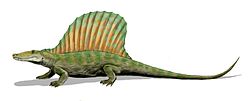| Secodontosaurus | |
|---|---|

| |
| Restoration of S. obtusidens | |
| Scientific classification | |
| Domain: | Eukaryota |
| Kingdom: | Animalia |
| Phylum: | Chordata |
| Clade: | Synapsida |
| Family: | †Sphenacodontidae |
| Genus: | †Secodontosaurus Romer, 1936 |
| Species | |
Secodontosaurus (meaning "cutting-tooth lizard") is an extinct genus of "pelycosaur" synapsids that lived from between about 285 to 272 million years ago during the Early Permian. Like the well known Dimetrodon, Secodontosaurus is a carnivorous member of the Eupelycosauria family Sphenacodontidae and has a similar tall dorsal sail. However, its skull is long, low, and narrow, with slender jaws that have teeth that are very similar in size and shape—unlike the shorter, deep skull of Dimetrodon ("two-measure tooth"), which has large, prominent canine-like teeth in front and smaller slicing teeth further back in its jaws.[1] Its unusual long, narrow jaws suggest that Secodontosaurus may have been specialized for catching fish or for hunting prey that lived or hid in burrows or crevices.[2] Although no complete skeletons are currently known, Secodontosaurus likely ranged from about 2 to 2.7 metres (7–9 ft) in length, weighing up to 110 kilograms (250 lb).
Fossils of Secodontosaurus have been found in Texas in North America in the Wichita and the Clear Fork groups of Early Permian formations. In recent years, teams from the Houston Museum of Natural Science have recovered remains in the Clear Fork Red Beds of North Texas that appear to be new specimens of Secodontosaurus. These discoveries are mentioned in online blogs[3][4] but so far have not been formally described.
- ^ Romer, A.S.; Price, L.I. (1940). "Review of the Pelycosauria". Geological Society of America Special Paper. Geological Society of America Special Papers. 28: 1–538. doi:10.1130/spe28-p1.
- ^ Reisz, R. R.; Berman, D. S.; Scott, D. (1992). "The cranial anatomy and relationships of Secodontosaurus, an unusual mammal-like reptile (Pelycosauria: Sphenacodontidae) from the early Permian of Texas". Zoological Journal of the Linnean Society. 104: 127–184. doi:10.1111/j.1096-3642.1992.tb00920.x.
- ^ "Dispatches From South Dakota: Willie The Dimetrodon [Day 2] | BEYONDbones". blog.hmns.org. Archived from the original on October 7, 2022.
- ^ Science, Houston Museum Of Natural (2007-10-26). "Secodontosaurus: The "Fox-Faced Finback"". Prehistoric CSI. Archived from the original on December 16, 2023. Retrieved 2024-02-18.